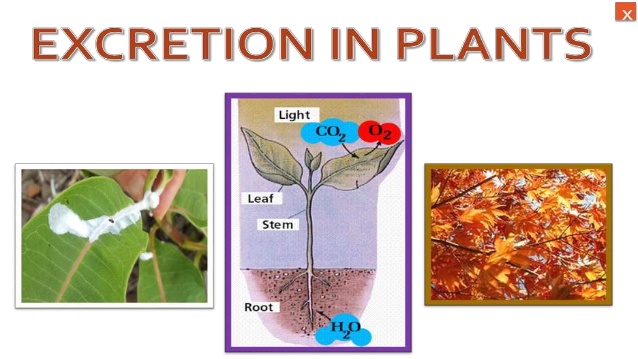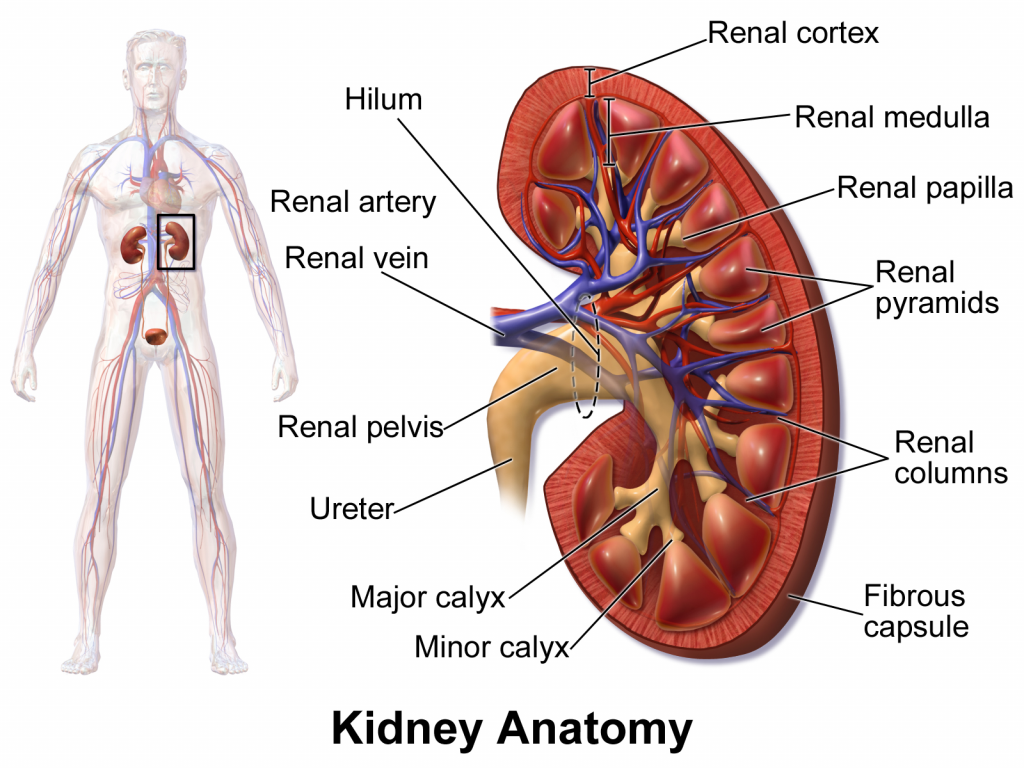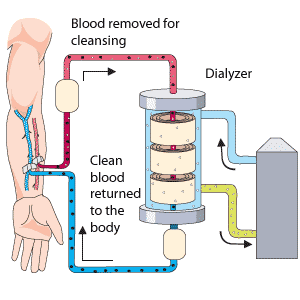Excretion
The biological process of removal of excess or toxic waste products of metabolism from the body of an organism is called Excretion.
If allowed to accumulate, these waste products of the organism’s cells would generally be harmful and prevent the maintenance of a steady state.
Excretion takes place in Plants as well as in Animals.
The living cells of organisms work all the time in order to sustain the life of the organism. Most of this work is done in the form of biochemical reactions. Examples of Biochemical process are – Synthesis of proteins, fats, carbohydrates, hormones, pigments, Oxidative breakdown of glucose, and many other Catabolic (breakdown) Anabolic (synthetic) reactions.
The biochemical reactions taking place in the cells of an organism may produce toxic wastes (poisonous wastes) in the body. The accumulation of toxic wastes in the body harms an organism.
So, for an organism to lead a normal life, the toxic wastes being produced in its body must be removed continuously.
Also Check – Diffrence between Excretion And Egestion
During the Biochemical Reactions in living cells
- Some metabolites are produced which may be toxic if accumulated in the cells and
- Water and salt content of the body may increase or decrease.
The two important homeostatic processes occurring in living organisms which help to maintain the steady state are :
- Excretion
- Osmoregulation
Osmoregulation
It is a process that maintains the amount of water and proper ionic balance in the body fluids. It maintains a constant osmotic condition in the body by regulating the water content and solute concentration of body fluids, particularly of sodium, potassium and chloride ions. The body fluids are cell contents, blood plasma, tissue fluid and lymph. Read more
Also Check – Significance of Excretion and Osmoregulation
EXCRETION IN PLANTS

- Plants produce a number of waste products during their life processes.
- As compared to animals, the plants produce waste products very slowly and in very small amounts.
- Plants have no special organs for waste removal like the animals.
3 Important Methods used by Plants to get Rid of Excretory Products
The plants remove their waste products by different methods. Plant wastes and the methods by which they are removed are as follows:-
- Gaseous Waste Products
- Solid and Liquid Waste Products
- Gums And Resins
1. Gaseous Waste Products
- The main waste products produced by plants are carbon dioxide, water vapor and oxygen.
- Carbon dioxide and water vapor are produced as waste during respiration by plants whereas oxygen is produced as a waste during photosynthesis.
- The gaseous wastes of respiration and photosynthesis in plants (carbon
- dioxide, water vapour and oxygen) are removed through the ‘stomata’ in leaves and ‘lenticels’ in stems and released to the air.
- The plants excrete carbon dioxide produced as a waste during respiration only at night time.
- The plants excrete oxygen as a waste only during the day time.
- Water vapor produced as a waste by respiration is excreted by plants all the time (day as well as night).
- This wastewater is gotten rid of by transpiration.
Also Check – How do Leaves of Plants help in Excretion ?
2. Solid and Liquid Waste Products
- The plants get rid of stored solid and liquid wastes by the shedding of leaves, peeling of bark and falling of fruits.
- The plants also store some of the waste products in their body parts. For example, some of the waste products collect in the leaves, bark and fruits of the plants or trees.
- Some of the plant wastes get stored in the fruits of the plant in the form of solid bodies called raphides. These wastes are removed when the fruits get detached from the plant. For example, the fruit called ‘yam’ (zamikand) has needle-shaped raphides on its surface.
3. Gums And Resins
- The plants excrete their wastes in the form of gum and resins from their stems and branches.
- The plants also excrete some waste substances into the soil around them. Read More…
Excretion in Animals

Animals usually have definite excretory organs through which they eliminate waste products and water.
Excretion in Aquatic Animals
- Aquatic animals have an advantage in getting rid of nitrogenous wastes because they are surrounded by water.
- In general, aquatic animals can allow ammonia to diffuse out of their bodies into surrounding water, which dilutes the ammonia and carries it away.
- Many need to either eliminate water from their bodies or conserve it, depending on whether they live in fresh or saltwater.
- In Freshwater ammonia often diffuses across the skin of an animal.
- Gills utilized for the process of excretion.
- Concentration gradient of water can cause issues as a result they produce very dilute urine, and pump salts inward through gills
- In Saltwater, the risk is that all of the water will diffuse out of the animal due to concentration gradient.
- Salt excreted across gills is very concentrated urine to conserve water.
Excretion in Avian Species
- The excretory system in birds is efficient and lightweight.
- It does not store waste liquids in a bladder as their is no urinary bladder in birds.
- Birds convert nitrogenous waste to uric acid, which is concentrated.
- Major excretory organs are the kidneys, the ureter and the cloaca.
- Two kidneys, each with a ureter that carries the urine produced by the kidneys to the cloaca, from where it is eliminated.
Read in details – Excretion in Animals
Excretion in Human Beings

- The major wastes produced by the human body are Carbon dioxide and Urea.
- Carbon dioxide is produced as a waste by the oxidation of food during the process of respiration.
- Urea is produced as a waste by the decomposition of unused proteins in the liver.
- Human body must get rid of these waste materials because their accumulation in the body is poisonous and harms us.
- The human body has different organs for the removal of wastes from the body.
- Human lungs excrete carbon dioxide and kidneys excrete urea.
- The main Excretory System in human beings is the Urinary System

Also Check- Compare the Functioning of Alveoli in the Lungs and Nephrons in the Kidneys with respect to their Structure and Functioning.
Excretory system( urinary system) in human beings consists of a pair of
- Kidneys
- A Pair of Ureters
- A Urinary Bladder
- and A Urethra.
Also Check – Why is the Removal of Faeces from the Alimentary Canal not considered to be Excretion
Kidneys

Location of Kidneys
- The two Kidneys are located towards the back of the lower part of the abdominal cavity, one on either side of the backbone.
- The left kidney is slightly larger and placed a little higher than the right kidney.
The blood from the Aorta enters into kidneys via the renal arteries and returns to the posterior vena cava via renal veins.
Urine formed in the kidneys passes by a pair of ureters to the bladder where it is stored until it is released via the Urethra.
Structure of Kidneys:
- There are two kidneys in humans. Each kidney is purplish-brown, slightly flattened and shaped somewhat like rajma bean.
- Internally a kidney is made of numerous microscopic excretory units called nephrons .
- Nephron is the structural and functional unit of excretion.
- Single kidney contains about a million nephrons, each approximately 3 cm long. Read More…
Functions of Kidney
- The most important function of kidneys is filtration of blood to excrete the waste products of metabolism.
- If these waste products, mainly nitrogenous waste such as urea and uric acid, are not removed from the blood, they will start accumulating to unbearable toxic levels.
- Besides filtering out the waste products, the kidneys perform other functions such as osmoregulation, secretion of erythropoietin, enzyme-renin and conversion of inactive form of vitamin D to the active form.
- The kidneys filter about 190 liters of blood to produce 0-9-1-9 liters of urine daily. Read More…
Structure and Function of Nephrons

Each nephron has a cup shaped upper end, called Bowman’s Capsule.
It contains a bundle of blood capillaries, called Glomerulus.
The blood entering into the glomerulus carries waste materials which are filtered out in the Bowman’s capsule.
Also Check – Functioning of Nephrons
Filtration is possible because the walls of glomerular capillaries and Bowman’s capsule are very thin and are selectively permeable.
This property of membranes allows water and small molecules in the blood to pass through them.
Once the waste material is filtered out, the blood free from these waste materials goes into the renal veins from where it goes into the heart through posterior vena cava.
ALso Check – Function of Nephrons
The fluid containing waste materials is forced out of the glomerular capillaries in the Bowman’s capsule.
The filtered out fluid is known as glomerular filtrate which contains sodium, potassium and chloride ions, glucose, amino acids along with urea, uric acid and a large amount of water.
Bowman’s capsule leads into a long tubular structure into which the glomerular filtrate moves away.
The tubular structure is convoluted, twisted, folded and has a U-turn before meeting the collecting duct.
Also Check – Structure of Nephrons
During the flow of glomerular filtrate in this long tube, reabsorption of useful materials and secretion of certain substances takes place.
The materials reabsorbed are glucose, amino acids, Na+, K+, Cl-, water, etc.
The fluid reaching the end of the collecting duct is called urine.
The Urine is fluid and dissolved waste substances excreted by the Kidneys.
Also Check- How is the Amount of Urine Produced Regulated ?
Human urine contains about 95% water and 5% nitrogenous substances (mostly urea, uric acid,etc.) and a few other substances.
Finally, the urine moves through the ureter and collects in the urinary bladder till thrown out of the body through urethra and urinary opening.
Urine is yellow coloured fluid due to the presence of urochrome pigment in it.
Also Check – Describe the Process of Urine Formation in Kidneys
Kidney Failure
- Kidneys are the most vital organs for survival of the organisms. Though the kidneys remain active throughout life, its efficiency gradually declines with the normal aging process.
- For example, its activity declines to about 50% by the age of 70 in human beings. The other causes of decline in the normal functioning of kidneys are diseases such as kidney infection, injury or restricted blood flow to kidneys.
- These abnormalities result in kidney damage and malfunctioning. A general term for decline in the performance of the kidney due to disease is kidney failure.
- Though it is not common, it may result in death within a couple of weeks if not treated properly. Kidney failure is often due to build up of potassium ions which causes heart failure.
- The failure of both kidneys immediately need medical intervention.
Also Check – What is Dialysis Class 10th
There are two alternatives of kidney failure
- Kidney Transplantation
- Artificial Kidney (Haemodialysis)
Artificial Kidney – Dialysis (Haemodialysis)

Artificial kidney is the Dialysis machine which is used in order to get rid of metabolic wastes from the blood and to maintain normal levels of water and mineral ions in body fluids.
The artificial kidney functions on the same principle as the normal kidney and the procedure is called Dialysis.
The blood is pumped out of the body and made to flow into the dialysis machine.
Heparin is added to the blood to prevent clotting.
The blood circulates slowly through the long cellulose tubes coiled in a tank filled with dialysing solution.
The cellulose membrane allows ions, very small molecules and water to diffuse through it.
The blood corpuscles, platelets and protein molecules are too large and do not pass through the membrane.
Finally the cleansed blood is pumped back into the patient.


7 Comments on “Excretory System Class 10”